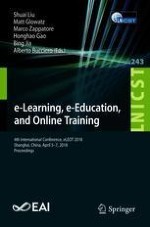2018 | OriginalPaper | Buchkapitel
Build Up Peer Instruction Based Flipped Classroom with Social Network
verfasst von : Ying Chen, Fei Lang, Zeguang Lu, Hui Shi
Erschienen in: e-Learning, e-Education, and Online Training
Aktivieren Sie unsere intelligente Suche, um passende Fachinhalte oder Patente zu finden.
Wählen Sie Textabschnitte aus um mit Künstlicher Intelligenz passenden Patente zu finden. powered by
Markieren Sie Textabschnitte, um KI-gestützt weitere passende Inhalte zu finden. powered by
